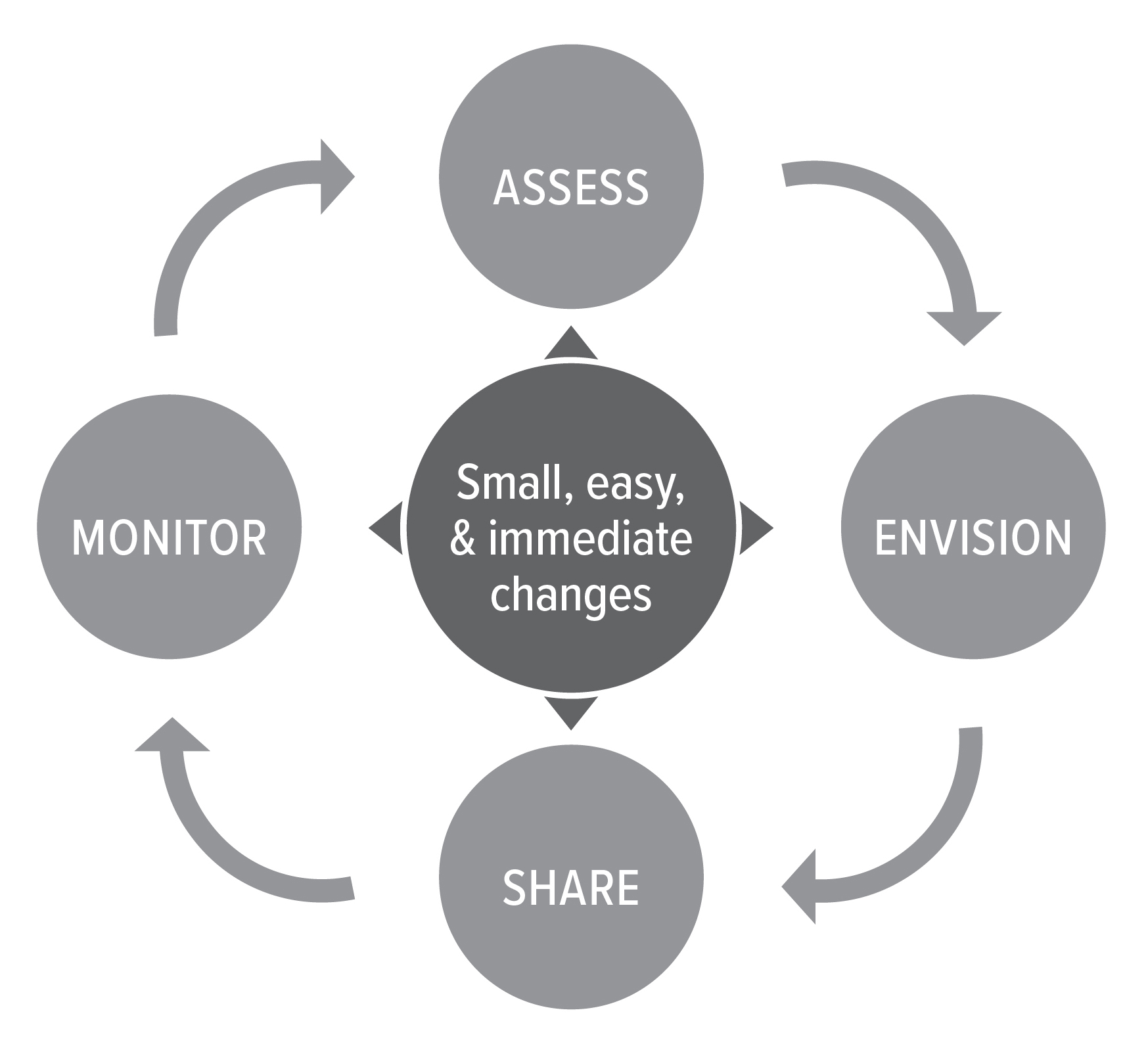Like Where You Work
The authors of The Culture Question: How to Create a Workplace Where People Like to Work believe that everyone should be able to like where they work. This is a compelling vision, and after reading the book I reached out to two of the four authors, ACHIEVE CEO, Randy Grieser, and ACHIEVE Managing Director, Eric Stutzman, to learn more about their thoughts.
Culture: How People Behave and Interact
What is your definition of culture?
Workplace culture is really about how people behave and interact. This includes how decisions are made, how disagreements are voiced, how conflict is resolved, and how people connect when they pass in the hall. Culture is the relational environment in which we work, and it’s how we work together. The simplest way we’ve come to describe culture is, “It’s the way things work around here.”
While culture is not physical, you can feel and see it in the language we use, our rituals, and the stories we tell. Even simple things like whether people feel comfortable displaying personal items on their desk or walls can tell you a lot about an organization’s culture.
We describe culture as being on a spectrum between healthy and unhealthy. Healthy cultures are full of energy and productivity, whereas unhealthy cultures produce unmotivated employees. Most organizations are not completely healthy or entirely unhealthy, but rather lie somewhere in the middle. Or there are parts of the culture that are good, and parts that are bad.
Why is workplace culture important?
The goal of most workplaces is to get things done. When we have a healthy workplace culture, it sets the stage for doing good work. In our opinion, culture is the most significant factor that influences work relationships, employee happiness, and productivity. We agree with the phrase attributed to Peter Drucker: “Culture eats strategy for breakfast.” You can have the most incredible strategy imaginable, but if you don’t have a healthy culture in which to execute your strategy, it’s just words on a page.
In our opinion, nothing impacts employee engagement more than workplace culture – and almost every leader and human resource manager we know would like to see engagement increase. The secret to improving employee engagement is culture.
What does it look like when leaders truly prioritize culture?
As leaders, we are all stretched in multiple directions. As such, it is tempting to focus on all our other operational demands at the expense of culture – culture becomes something we will eventually get to once other priorities are dealt with.
Healthy cultures require intention and effort. When leaders prioritize culture, it becomes part of the daily and weekly conversations they have with others – culture may even become the agenda item for a meeting. The good news is that when operational challenges emerge in organizations with healthy cultures, everyone is more willing and able to rise to the occasion.
Common Leadership Mistakes
Are there common mistakes that leaders make when thinking about culture?
Some leaders and organizations rely on perks or one-off wellness initiatives in hopes of improving culture. Foosball tables and free food in the cafeteria are nice, but they really don’t move the needle in the long run when it comes to sustaining a healthy culture.
Another thing we’ve seen are leaders who keep culture at arm’s length and outsource it to other departments or committees. While culture is influenced by everyone in the organization, leaders need to recognize that they play a major role in creating and sustaining it.
Key Questions to Improve Culture
What are some key questions leaders should ask when they want to reflect and improve organizational culture?
We believe leaders should start by asking, “How does my organization’s culture impact how much people like working here?” and, “What can we do to make it better?” Whether you pay attention to it or not, culture is impacting employee engagement – either positively or negatively. Instead of leaving it to chance, leaders should be asking these questions regularly.
It’s important to note that very few leaders we interviewed and work with feel like they have a perfect culture. Even within our own organization in which we’ve been incredibly thoughtful about how to create a healthy culture, we see room for improvements. A healthy culture is much like a car that requires regular, ongoing maintenance so it can continue to serve its purpose. In our book, we refer to a framework we call The Continuous Improvement Cycle, which is designed to help organizations monitor their culture.
The Continuous Improvement Cycle
Practice Constructive Conflict Management
What tips would you offer leaders who want to practice constructive conflict management?
Like all things related to culture, leaders set the tone when it comes to practicing constructive conflict management. According to our research, having leaders who respond to conflict quickly is highly correlated with having a great place to work.
Leaders can address conflict quickly by listening to people and coaching them through their options for how to respond. Leaders should be asking people who report a conflict three fundamental questions:
- What if the other person or side doesn’t have bad intentions towards you?
- What power do you have to change what is happening in constructive ways?
- What do you want to do next and how can I support you to do that?
In addition to these three questions, leaders should help staff focus on anchoring their conflict resolution conversations in the values and purpose of the company. Leaders should emphasize that resolving conflict constructively is a work expectation – it’s part of the job because it helps an organization perform in such a way that allows it to live out its purpose.
How do you best sustain a positive culture in the midst of constant change and external market pressure?
 One of the hallmarks of a healthy culture is that leaders communicate change well. When it comes to challenges or changes impacting the organization, we have learned to do the following: Communicate changes or issues as early as you can so people have time to process the information, and communicate the information often. Don’t just communicate once – communicate regularly as things develop and evolve.
One of the hallmarks of a healthy culture is that leaders communicate change well. When it comes to challenges or changes impacting the organization, we have learned to do the following: Communicate changes or issues as early as you can so people have time to process the information, and communicate the information often. Don’t just communicate once – communicate regularly as things develop and evolve.
For change to happen effectively, communication must be anchored in trust. Organizations that are able to sustain a positive culture in the midst of change do so primarily because they have been able to establish trust. When employees trust their leaders, they will give you latitude as you navigate the realities of market pressures and change.
6 Key Elements of a Healthy Culture
What are the hallmarks of a positive culture?
Practically speaking, we’ve identified six key elements of a healthy workplace culture: communicating purpose and values, providing meaningful work, focusing your leadership team on people, building meaningful relationships, creating peak performing teams, and practicing constructive conflict management.
You know you have a positive culture when people are proud of your organization and actually like working there. As a result, turnover is low because people don’t want to leave your culture. When in conversation with others, they are loyal to you and speak highly of your organization. These are clues you have a positive culture.
6 Key Elements of a Healthy Culture
1: Communicating purpose and values
2: Providing meaningful work
3: Focusing your leadership team on people
4: Building meaningful relationships
5: Creating peak performing teams
6: Practicing constructive conflict management
Why is The Culture Question important?
Through our own experience, our work with others, and our research, we have come to understand the factors that are required to create a healthy workplace culture. We know what great workplaces are doing, and what others are not doing. The Culture Question takes the mystery out of how to create and sustain great workplace cultures. It goes beyond using simple strategies like free food and employee rewards to improve culture, and instead provides a realistic and helpful framework for creating a healthy culture.
Unfortunately, far too many people don’t like where they work, and we believe this is totally unnecessary and almost entirely avoidable. Our goal in writing this book is to help every organization become the kind of place that is good for human interactions and relationships – the kind of place where people like to work.
For more information, see The Culture Question: How to Create a Workplace Where People Like to Work .




